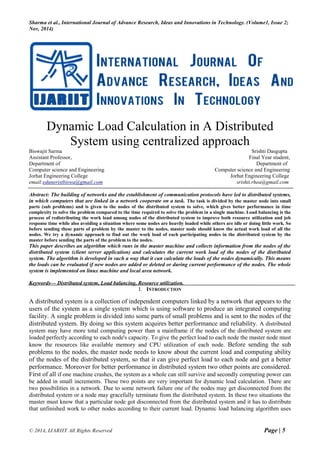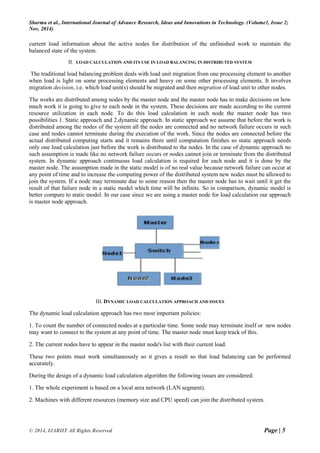The document presents a dynamic load calculation algorithm for distributed systems, where a master node monitors and balances the workload among computing nodes to enhance performance and resource utilization. It distinguishes between static and dynamic load balancing approaches, emphasizing the necessity of continuous load assessment as nodes may connect or disconnect during operation. Implemented in a Linux environment, the algorithm ensures optimal task distribution based on real-time resource availability while maintaining system stability during node failures.




![Sharma et al., International Journal of Advance Research, Ideas and Innovations in Technology. (Volume1, Issue 2;
Nov, 2014)
© 2014, IJARIIT All Rights Reserved Page | 5
REFERENCES
[1] Parveen Jain and Daya Gupta “An Algorithm for Dynamic Load Balancing in Distributed Systems with
Multiple Supporting Nodes by Exploiting the Interrupt Service” in International Journal of Recent
Trends in Engineering, Vol 1, No. 1, May 2009.
[2] Vatsal Shah and Kanu Patel “Load Balancing algorithm by Process Migration in Distributed Operating
System” in international Journal of Computer Science and Information Technology & Security
(IJCSITS), ISSN: 2249-9555 Vol. 2, No.6, December 2012.
[3] Rafiqul Zaman Khan and aved Ali “ Classification of Task Partitioning and Load Balancing Strategies in
Distributed Parallel Computing Systems” in International Journal of Computer Applications (0975–8887)
Volume 60–No.17, December 2012.
[4] Jayna Donga , Vatsal Shah, Kanu Patel and Rahul Goradia “Process Division and Migration based Load
Balancing for Distributed Operating System” in International Journal of Advanced Research in Computer
Science and Software Engineering Volume 3, Issue 12,December 2013.](https://image.slidesharecdn.com/m1p2-1146-161130092627/85/Dynamic-Load-Calculation-in-A-Distributed-System-using-centralized-approach-5-320.jpg)